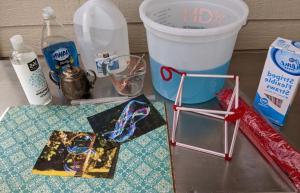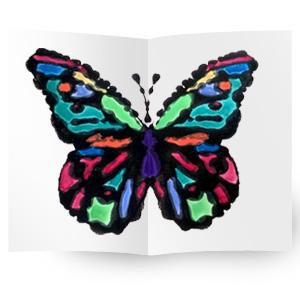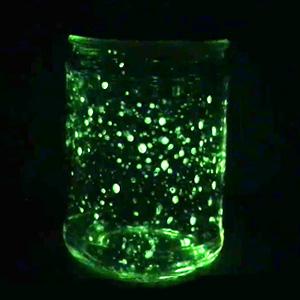Supplies:
For solution:
- Clean container, big enough to hold your solution
- Distilled water (tap water will work but distilled water is best)
- Dishwashing liquid like Dawn
- Glycerin
- White sugar
For Bubble cube:
- 7 pipe cleaners, cut in half
- 12 plastic straws, each one cut to fit a pipe cleaner half, with about ¼-½” of pipe cleaner left exposed at each end
- For the bubble blower, you’ll need a plastic pipette. Just snip ½” off the bulb end of the
pipette. This is the end you’ll dip into the bubble solution.
Directions:
- Start with a clean container that will hold as much solution as you plan to make.
- Add distilled water (tap water can be substituted, but the minerals in it will affect the bubbles), in 1 cup increments.
- For each cup of distilled water, add 2 Tbsp of dishwashing liquid (original Dawn works really well).
- For each cup of distilled water, add 1 Tbsp of glycerin (grocery story grade, or pharmaceutical grade).
- For each cup of distilled water, add 1 tsp of white sugar.
- Gently stir the ingredients in the container, being careful not to make it frothy and bubbly.
- Cover the container and place it in the refrigerator overnight.
Meanwhile... make a bubble cube and a bubble blower for your Bubble Magic …
- Twist 3 of the pipe cleaner halves together at one end to make a triangular, pyramid-shaped component. Use 12 of the pipe cleaner halves to make a total of 4 of these three-legged pieces.
- Slide a piece of straw onto each pipe cleaner leg, leaving ¼-½”” sticking out of the open end.
- To build the cube, twist each pipe cleaner end on one component to the ends on another component. Continue connecting the legs until the cube is complete. Try to make the shape as even as possible.
- Use the last two pieces of pipe cleaner for handles by twisting each piece onto the cube at opposite corners. Curve the “handle” ends to make a shape that you can easily hold onto.
Now to make Bubble Magic …
- Get the cold bubble solution from the refrigerator, and carefully stir the mixture. Avoid making froth and bubbles. Whenever that forms on the top, take a minute to skim it off with a spoon so that you’ll get better bubbles with your cube.
- Dip your cube into the solution, letting it sit there for a few seconds, and lift it out by holding on to the two handles. Gently shake the cube so that the soap film can even itself out and excess solution can drip back into your container.
- Gently shake the cube again so that you can see a new shape, with a “square” bubble in the center. Be sure the “square” is horizontal so that you can see the square when you look down into the cube from above it.
- Set the cube gently on a flat surface to keep the bubble film stable while you prepare a bubble with your pipette bubble blower, or ask a friend to blow a bubble with the pipette.
- Blow a pipette bubble and gently drop it right into the center of the square. And ...
TA-DAH! The round bubble you dropped into the cube “magically” turned into a bulging cube … a square bubble. Now that’s Bubble Magic!
*You can also use your bubble cube as a wand. Submerse it in the solution, lift it out carefully, and holding the handles, “pull” it through the air. Watch for a trail of connected spherical shapes!
Watch this project at : https://youtu.be/iY_0gSND-40?list=PLMEg2Dd0dSFctLfDQxsL5SmuE8zkwQFmu
Supplies:
- A piece of 8 ½ X 11 white cardstock
- Watercolor paints
- School glue
- Small bottle of black acrylic craft paint
- Small paintbrush
- Cup of water for rinsing your paintbrush
Directions:
- Print the half butterfly image provided (see below) onto your cardstock. Fold the cardstock exactly in half and then unfold to make a crease in the middle. (Alternate method: Draw a butterfly picture onto half of your cardstock with a pencil putting the exact middle of the butterfly on the crease.)
- Make black glue by adding black acrylic craft paint to a small bottle of plain school glue until a dark, black color is achieved. Mix well.
- Using the tip of the glue nozzle, trace a fine line of glue onto all of the printed lines of the butterfly picture. Don’t use too much glue! Put the glue on only the half of the picture with the copied lines. Leave the other half blank.
- Fold the paper in half again while the glue is wet and press together gently. Then open up the cardstock. The pattern you traced will now be duplicated on the other half of the cardstock.
- Let the glue dry. You can speed up the process by using a blow dryer on low heat to gently dry the glue.
- When the glue is completely dry, use your watercolors to color in all of the white sections. You can decide which colors to use!
Oops! My butterfly isn’t exactly the same on both sides. That’s okay! Real butterflies’ wings aren’t exactly the same on both sides, either! Just like with people’s faces, one side is slightly different than the other.
Watch this project at: https://youtu.be/Gimm3roL-3Q
Supplies:
- Clean, clear jar with lid
- Thin glow stick
- Scissors
- Table covering or tray
- Glitter (optional)
Directions:
- With a grown-up's help, cut the tip off the glow stick.
- Place the open end of the glow stick in the jar and shake it back and forth so that it splatters. Turn the jar as you splatter.
- Add a small pinch of glitter, sprinkling onto the sides of the jar where the splatters are.
- Cover with lid and take into a very dark room.
Fireflies are not flies but beetles and do exist in Colorado! They hang out by permanent water sources like ponds, lakes, and streams.
Watch this project at: https://youtu.be/LRNWJVQRFYw





